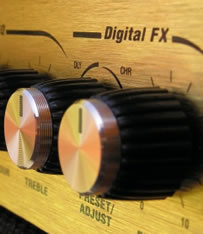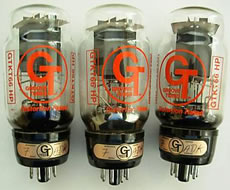|
www.learn-to-play-rock-guitar.com |
 |
||||
Guitar Amp GuidelinesWhether you are just getting started or a pro, there are some basic guitar amp guidelines to follow when choosing an amplifier. What's Your M.O.?First and foremost, what are you trying to accomplish? Why are you buying this amp? Are you brand new to guitar and just want to be able to take some lessons and learn some songs? Or do you want to start playing in a band? Do you play another instrument and are looking to expand your capabilities? Knowing this up front will help you reach your goal quicker and save you some money in the process. If you're starting out and the goal is to just learn guitar for your own enjoyment, you don't need anything fancy. Again, a micro-amp or a USB/modeler interface to your computer are more than enough to open up the world of guitar playing to you. More than likely, you'll be playing in your home and nowhere else, so a low wattage amp will give you all the volume you need. You'll have distortion and maybe some effects built-in. And, if you keep these guitar amp guidelines in mind, you won't be upsetting the neighbors… Or maybe that's your goal??? Maybe you want to drive the neighbors crazy, hmmm? You really should use your power for good, ya know… If the ultimate goal is to play for audiences, the guitar amp guidelines change a bit. You will need a rig that can compete volume-wise with your fellow band-mates. You should start looking at amplifiers in the 40 to 60 watt range. This wattage will give you enough volume to play in small to mid-sized clubs. A combo amp with one or two 12" speakers is great for practicing, and when playing a gig, if you need to project more for an audience, you can mic the amp through the sound system. If you end up getting a separate head, you'll also need a speaker cabinet. Typically the matched head and cab are optimized for each other and will produce decent tone, but don't be afraid to try the head with another cabinet. You'd be amazed at the difference in tone that using another manufacturer's cab can create. Not only when different speakers are used, but also the cabinet design can significantly change the tonal output. Most likely, with a combo or separate amplifier head, you'll be limited in the onboard effects, so if you plan on using these a lot, you can look at a modeling amp or plan on buying an effects pedal board. Which ever route you take, modeling amp or pedal board, pricing for these ranges from a few hundred dollars to well over a thousand bucks US. $$$And that brings us to our second set of guitar amp guidelines – what's your budget? 
Even if money is no object when you're getting started, I wouldn't recommend spending a couple thousand dollars on the biggest, hottest stack you can find. You need to get comfortable with your guitar, and while an amp can mask some guitar learning sloppiness, it's not going to make you any better. Only practice and some helpful guidance will do that for you. If money is tight, check out the cheap guitar amps page for some ideas. Get out there and try some amps before you make a decision on what to buy. You have to feel comfortable with the purchase, so you don't want to rush into anything. You don't want to find a guitar amp that looks good but ends up being a piece of crap. Whether buying used or new, nobody likes bad surprises! You need to be able to give that salesperson some direction in helping you find the right guitar amp for your needs right now. After all, a salesman's job is to sell. If you go into a store wanting a Mesa Boogie because "that's what so-and-so uses", you can drop a ton of cash getting a guitar amp you don't need yet. If you find a good salesperson, they'll guide you to a sensible purchase because if they treat you right, more than likely you're gonna come back and get the next amp from them. Most salesmen in music stores are musicians and will give you guitar amp guidelines to help you make an informed decision. If you're buying from a private owner (or pawn shop), you're probably going to have to rely on your gut. Don't be afraid to run the guitar amp through its paces. Crank some volume (you don't need to hit 10, though!) and test the sound – are you happy with the tone? Any funky hiss, crackling or popping when you adjust the knobs? Some hiss is normal as volume increases, but you don't want it to dominate , Tube, Solid State or Modeler?
Well, we're back to more questions. It's hard to give you guitar amp guidelines around personal choice. Tube amps are usually more expensive than solid state (and modelers for the most part are solid state as well). They also require more maintenance and need to be babied when you handle them. They're also heavier! But on the plus side, tube amps end up giving you the warmest tone. Solid state amps used to be looked down on because you couldn't get the same warm tones out of them that you could with the traditional tube amps. They tended to lack a bottom end tone. Well, solid state has come a long way, and today there are many guitarists that use solid state in the studio and on stage. The nice thing about a modeling amp is you can have virtually any sound you're looking for encased in one amplifier. You can even get tube modeling amps for incredibly authentic tone. You can get some good modeling guitar amp guidelines from the artists that use Line 6 products here. One feature that's common for many mid-high priced amps is multiple channels. For instance, you can set one channel to a clean sound and a second channel to a crunch tone. Add a foot switch to the mix and you can change between sounds whenever you need to. Sometimes the footswitch is included with the amp, sometimes it's not. Again the key is to know what you want to do and how much to spend... Many of the online music stories offer advice on purchasing gear. One of the better Guitar Amp Buyers Guides can be found here at Sweetwater's website. Here are some additional articles to help you make a good informed decision: These should be enough guitar amp guidelines to get you started down the road to amplifier ownership. You'll learn a lot along the way as you test various amps out. Listen to what others have to say, and spend as much possible time jamming to help you define your ultimate sound. Head back to the guitar amps page for links to the different manufacturers – for their resources and guitar amp guidelines. Of course they'll be trying to sell you on their gear, but you'll find tidbits of useful information that can also help you decide what you want.
Back to the Guitar Amps page... Back to the Learning To Play Rock Guitar Homepage |
|
||||
|
div align="center">
Enjoy This Site?
Then why not use the button below, to add us to your favorite bookmarking service? |
|||||
| Subscribe! | Contact Us | Link To Us | About Me | Sitemap | Disclosure | Privacy | Terms and Conditions |
|
|||||
|
©Copyright 2007-2025 Sound Copywriting, LLC ~ All rights reserved. | |||||

